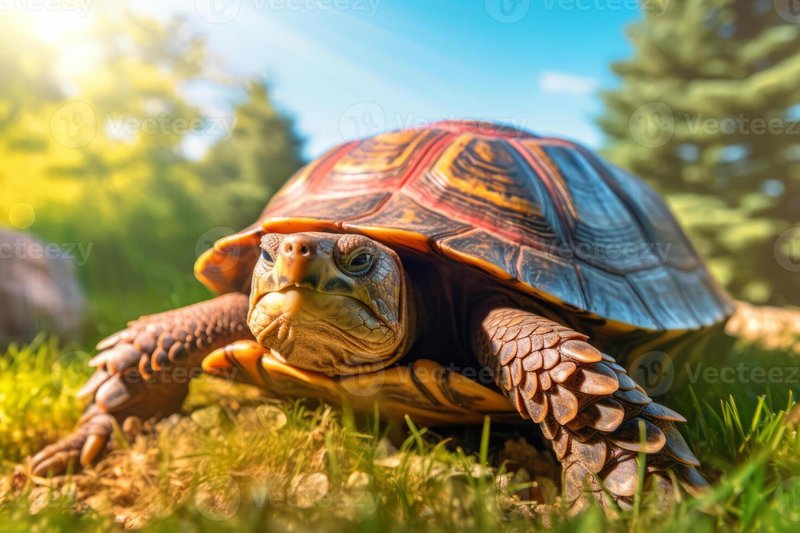
These adaptations are like a survival toolkit that turtles have been perfecting since the time of the dinosaurs. They’re not just about evading predators; they also help turtles thrive in different environments, from lush jungles to arid deserts. Let’s take a closer look at what makes the turtle a true survivor.
The Turtle’s Shell: Nature’s Armor
Turtles are best known for their hard shells, which serve as a protective armor against predators. This shell isn’t just a single piece; it’s actually made up of two parts: the carapace (the top) and the plastron (the bottom). The shell is composed of bone and cartilage, covered with layers of keratin, the same material found in our nails and hair.
When a turtle feels threatened, it can retract its head and limbs into its shell. This ability acts as a shield, making it harder for predators to reach them. Think of it like a superhero putting on their armor before heading into battle. Different species of turtles have shells that are adapted to their environments. For instance, some aquatic turtles have flatter shells to help them swim more efficiently, while land turtles have domed shells for better defense.
Interestingly, the shells are also a part of the turtle’s skeleton, which means they can’t simply shed it like a snake sheds its skin. This unique adaptation emphasizes the importance of their shell in overall survival and growth.
Lifespan: Masters of Longevity
Turtles are famous for their long lifespans. Some species, like the Galápagos tortoise, can live well over 100 years! This longevity is a fantastic adaptation in its own right. A longer life means more opportunities to breed and pass on genes to the next generation.
But why do turtles live so long? One reason is their slow metabolism. Unlike many other animals that require constant energy and food, turtles can go without eating for extended periods. This ability not only helps them survive in times of scarcity but also reduces their risk of predation. Imagine being able to hit the pause button on life whenever it gets tough! It’s this kind of adaptability that has allowed turtles to remain on Earth for millions of years.
Furthermore, their slow reproductive rates mean they invest a lot of energy into raising each offspring, ensuring that they have the best chance of survival.
Size and Camouflage: Blending in with the Environment
When it comes to survival, size and camouflage can be crucial. Many turtles have adapted to their surroundings in clever ways. For instance, smaller turtles can hide in crevices or among rocks to avoid predators. Larger turtles, like the leatherback sea turtle, can swim in deep waters where few predators can follow.
Camouflage is another powerful tool. Turtles often have shells that mimic their surroundings, making it harder for both prey and predators to spot them. This is particularly effective for turtles that live in water, where their shells can look like floating debris or rocks. Think about how some spiders blend into their environment; turtles do the same thing, but with their shells!
This combination of size and the ability to camouflage allows turtles to navigate through a variety of ecosystems while keeping a low profile.
Dietary Adaptations: What They Eat Matters
Turtles are not just picky eaters; they have specific dietary adaptations that help them thrive in their environments. Depending on the species, their diets can range from herbivorous (plant-eating) to carnivorous (meat-eating) or omnivorous (eating both). For example, green sea turtles mainly consume seagrasses and algae, while snapping turtles are known for eating fish, insects, and even small mammals.
This flexible diet allows turtles to take advantage of different food sources depending on what’s available. If you think about it, being able to adapt to what you can find is a survival skill that’s invaluable, especially in changing environments. Moreover, some turtles can store fat in their bodies, helping them survive when food is scarce.
Turtles’ beaks are also specialized for their diets. Some have serrated edges for tearing plants, while others have strong jaws for crushing shells. These adaptations make their feeding more efficient and successful.
Behavioral Adaptations: Survival Strategies
Behavior plays a significant role in a turtle’s survival. Many turtles exhibit behaviors that enhance their chances of survival in the wild. For instance, some species of turtles will bask in the sun to regulate their body temperature and maintain optimal metabolic function. This is particularly important for cold-blooded animals like turtles, as they rely on external heat sources for energy.
Additionally, turtles engage in migratory behaviors to find better feeding grounds or breeding locations. The leatherback sea turtle can travel thousands of miles across oceans, showcasing incredible navigation skills. This migration not only helps them find food but also avoid overcrowded areas where competition for resources may be high.
Another survival strategy is their ability to go dormant. During harsh weather conditions or when food is limited, some turtles will burrow into the ground and enter a state of dormancy, waiting for better conditions to return. This behavioral adaptation is a prime example of how turtles have perfected the art of survival.
Reproductive Strategies: Keeping the Species Alive
Reproduction is critical for any species, and turtles have developed fascinating strategies to ensure their survival. Most turtles are oviparous, meaning they lay eggs. Female turtles typically return to land to nest, digging holes in soft sand or soil to lay their eggs.
The number of eggs laid can vary greatly. Some turtles may lay a few dozen eggs, while others can lay hundreds! This approach is a smart survival strategy; by producing many eggs, there’s a better chance that some will survive to adulthood despite the many risks they face.
Interestingly, the temperature of the sand where the eggs are laid can determine the sex of the hatchlings. Warmer temperatures tend to produce females, while cooler ones lead to males. This fascinating adaptation gives species an advantage, allowing them to adjust to environmental conditions and ensure a balanced population.
In summary, the reproductive strategies of turtles exemplify their adaptability and resilience in the face of challenges.
Turtles are incredible survivors, and their adaptations are nothing short of remarkable. From their tough shells acting as armor to their long lifespans and clever feeding strategies, they’ve perfected the art of surviving in diverse environments. Each adaptation tells a story of evolution and resilience, reflecting their ability to cope with the challenges of life.
As we explore the world around us, let’s remember the incredible journey of turtles. They remind us of the importance of adaptability and the power of evolution in shaping the very essence of life. So, the next time you see a turtle, think of it not just as a slow-moving creature but as a symbol of survival — a true testament to resilience in nature.

